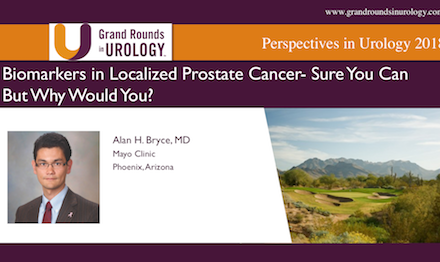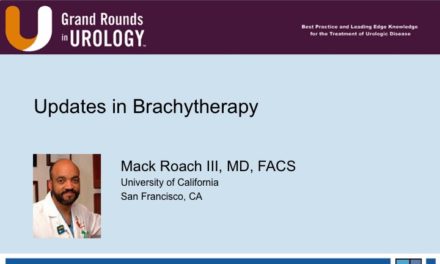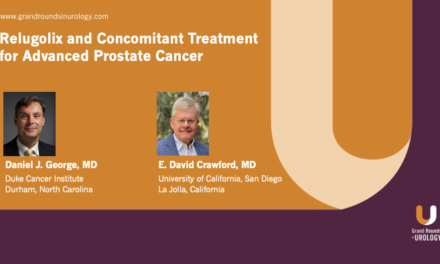Dr. Michael S. Cookson presented “Prostate Cancer: Why the Controversy?” at the 26th Annual Perspectives in Urology: Point-Counterpoint, November 10, 2017 in Scottsdale, AZ
How to cite: Cookson, Michael S. “Prostate Cancer: Why the Controversy” November 10, 2017. Accessed Apr 2024. https://dev.grandroundsinurology.com/prostate-cancer-why-the-controversy/
Summary:
Dr. Michael S. Cookson, MD, MMHC, provides an update on the latest AUA recommendations and touches on some of the controversy around the 2012 changes for treating prostate cancer, and what happened thereafter.
Prostate Cancer: Why the Controversy?
Transcript:
MICHAEL S. COOKSON: All right, thank you very much for that nice introduction. It’s a pleasure to be here. I think I’m going to warm us up with a little bit of prostate cancer talk. Then later today, we have a bladder session, so I’ll rejoin you.
I think this was placed in the primary care/urology for both of us to get together and try to come up with a better path forward. We know that as urologists, when we think about prostate cancer and prostate cancer, screening is sort of a no-brainer. Why wouldn’t you want to know early? Why wouldn’t we want to find out and offer options for men at an earlier stage than finding out too late as we often see?
We think about things like Pat Walsh’s advice or maybe Ball Carter’s book. There is a contingency out there that sort of opposes us. It’s larger than urology, and there are books like the Invasion of the Prostate Snatchers out there, things like that. It’s not all warm and fuzzy when we get outside our comfort zone of our urology meetings and our urology brethren.
I want to provide us with a little bit of an update on some prostate cancer facts, talk a little bit about the screening studies that we know, some of the controversy around the 2012 changes, and then what happened thereafter. Then I’m going to talk a little bit about the latest AUA recommendations too. I just want us to realize that we’re against—it’s an upward battle for us. We’re certainly not in the majority, and we have plenty of messaging and work to do before we can get consensus on this.
We know that prostate cancer is the number one male cancer. The rates are declining, but there’s over 161,000 new cases and 26,000 deaths. We’re proud to say that we’re not the number two leading cause of death anymore. We’re moving down and that’s important. Lung and colon cancer are more of a lethal threat to men these days.
This is the classic graph that we know happened when PSA became available. We saw widespread use of PSA. It led to the detection of not only incident, but prevalent cases. It peaked and then it’s been declining. Nevertheless, the decline has accelerated in lieu of some of these policy statements that have been sort of against screening.
The good news on the natural experiment of the United States is there’s been a decline in the mortality of men with prostate cancer, as I mentioned earlier. It’s somewhere around 3 % per year annually over the last 5 to 7 years. In the natural experiment, we’re saving lives, and something’s working to our advantage, even if we can’t get the policy statements and the high-level evidence to convincingly prove it.
We know that PSA surrounds this controversy. Later today, you’re going to hear about smarter PSA, better ways to use PSA, things like that. Certainly, PSA was revolutionary in our ability. Anyone who treats a tumor would love to have a marker like PSA to help in its management. It’s just that it has to be managed, and it has to be used appropriately.
The two main, randomized clinical trials that are out there that people often look at when they try to justify screening are the PLCO, which was the US study. Dr. Crawford was a major investigator in that. It was really though the problem was that doing a randomized study in the United States where you convince men that it’s important to do this PSA testing.
On the other hand, you’re not going to do testing or you’re going to do some sort of usual care created a problem. PSA was already being used like wildfire in the United States. In Europe, they had a little bit of an advantage because they weren’t doing widespread PSA testing.
The European study had a little less contamination, as you’ll see, but it also had its own problems. It wasn’t just a single study; it was multiple studies from different countries. They had kind of a combination, more of a meta-analysis approach to the screening.
This was the biggest problem we faced. This was a 2012 US Task Force Policy Statement that came out against prostate cancer screening. They’d had an earlier version that was sort of against older men—over the age of 75. I think that was around 2010. This one was against screening in general. That grade D recommendation hit squarely.
Then that subsequently resulted in a decline. There was some good news. Less older men, as shown on the yellow bar there, were tested—so men over the age of 75. Also suddenly, younger men were not being tested either. That decline had consequences too which we’ll show.
Getting back to the reality we know and believe is that death rates from prostate cancer were declining. We have better therapies for some more advanced—and we’ll talk about the advanced therapies, I think, towards Sunday, but they’re not curing the cancer. The best way to cure these patients was to actually detect early, potentially aggressive cancer, and treat it, and then you’d have a win.
We have to look at these screening trials with a grain of salt and talk about how that gets managed in routine clinical care. We’ll just briefly look at those.
This was the PLCO study. It had about almost 77,000 men in it. The men were divided up into screening which was annual screening compared to sort of usual care. That went on for several years.
I think it was up to six years, the randomization and the screening took place. Not all men had a biopsy. I think they used a threshold of around four to trigger a biopsy.
The story went that we know that we found more cancers in the men who were screened. The PSA at good at detecting cancers when men went to undergo biopsy versus the community standard.
What we found was that there wasn’t any long-term data to clearly show that we were reducing deaths the way the trial was originally designed. That was a problem. When the US Preventive Task Force Services looked at the data, that was kind of leading to their conclusions.
Now the criticisms of this are many, but the usual care definition was a moving target in changing. That led to as many as 80 or 90 % of men in the usual care on control arm going out and getting a PSA test. The study was never powered really to be able to determine differences if everybody was going to go out and do that. There were other issues along the way. I think the biggest problem is the contamination issue that was never really well thought out when they had the trial design.
The European study was a little bit larger study. We had about 77,000 men in the US study; there were about 180,000 men in this one. The majority of these men were not screened every year, but there was some that were screened every other year. Generally, it was every four years. Similarly, they had biopsy thresholds for PSA, and they had less contamination due to the fact that, at least in Europe, there wasn’t that community standard to PSA screen everybody.
The good news about this study was that it did show a significant reduction in death from prostate cancer. It was about a 21 % in that. After adjusting out for some contamination, etc., it could be as high as a 30 % relative risk reduction. In some statistical ways, they found that you probably need to screen somewhere around 37 men to detect a cancer and save that man, potentially.
There are criticisms of this as well. Like I said, there were different countries involved in the studies. They may not have had enough follow-up to really see the true benefit. Nevertheless, this one wasn’t our problem. Our problem was really the PLCO study.
There was another European study that was included, I think, in it—the Swedish study, the Goteborg study. It had 20,000 men. The reason that it was an important sort of subset study if you will is that it looked at younger men which is the men we’re trying to target. The average age was around 56 years. It was the youngest of those trials that I’ve touted so far.
They showed somewhere in the range of about a 44 % risk reduction in deaths from prostate cancer and only needed to screen, say 12 men, to really come up with this type of a value. That’s an important thing that was kind of thing that was kind of ignored by the US Preventive Task Force Services.
If you looked at it in summary, you can say that while there’s these screening trials out there, I think they focus pretty heavily on the PLCO results instead of really on the European study. Why they sided with one versus the other, I don’t know. I think that it could be made a good argument.
I didn’t have time to update it, but there’s a new paper that, I think David Crawford was on in the Annals of Internal Medicine in October which took the individual data from the European study and the PLCO study, took the raw data and statistically kind of corrected for the screening intensity. Even using all the data together, you could make a good argument for somewhere in that 20 to 30 % range risk reduction for prostate cancer.
If we believe this and as urologists, we need to get this message out. We got a problem. In the South—maybe, where I was at Vanderbilt, in the Southeast—we would say we have a failure to communicate.
We’re not doing a good job of teaching our primary care brethren that the value is there and that we know how to manage these people, and perhaps thoughtfully detect their cancers, and manage them once we’ve discovered. Some of the origin is the failure to underappreciate the benefit that we’re saving lives and that some of these men we detect will have aggressive cancers, and we have, certainly, effective treatment to help them.
Another one is an overestimation of the harms. One of the things that was sort of a thought process with the panel was every man that we diagnose is going to get a radial treatment of some sort. This is underestimating the value of reassurance as well. This was a study in JAMA where they did some decision analysis and looked at what would you rather be.
The A group was the I don’t know. I didn’t do a PSA, and I don’t know my value, but I think I don’t have cancer. That wasn’t very comforting to those men. The Bs were people that had no cancer and a normal PSA, so they’re reassured. Then the Cs were the people who had to go through the screening, but then turned out not to have cancer. They were happy that they didn’t have the cancer. If you look, it was clear that, at least in this group, men sort of valued the idea of knowing that they weren’t sitting on a time bomb. They didn’t have cancer.
This goes back to the overestimation of harm. In the data that they collected, they made estimations based on kind of Medicare data for radical prostatectomy, especially in the open air and historical data. The rates of complications were higher. I think even just uncoupling treatment from the diagnosis is really the most important thing.
This is just shows that many men that we diagnosis today have lower risk cancer. David’s going to talk later about some of the genomic tools that we use in additional to the clinical tools. We are all endorsing active surveillance and active monitoring for these men. It’s not a given that they go on to receive radical treatments and have complications as those books would suggest.
Even in some men, who do want treatment or who do find active surveillance unacceptable but have lower risk cancers, were applying more local treatments, focal treatments, whether that’s cryo, HIFU, some newer technologies or emerging. We’re learning to do the male equivalent of a lumpectomy in the right setting. Imaging and all these things have added up to better ways for us to assess their cancers.
Nevertheless, that preventive task force services did their recommendation. That had consequences. What were the consequences of that? One was that there was less screening going on by primary care. We already know that the primary care do most of the initial PSA testing. This showed that, not only were they not doing PSA testing or screening in older men, which may be acceptable, but in the younger men, they were also being left out.
This was another study that looked at sort of a national survey. It looked at PSA testing and DRE testing after that 2012 mandate and found that both the rectal exam was way down, and the PSAs were way down as well. Again, it gets back to the implications of this in the common primary care world where most of the battle is being fought.
This also showed that recommendation. If we’re not doing the PSA testing, naturally, we’re not going to have as many patients come forward to undergo evaluation and biopsy. That was borne out in this review of the Medicare database.
Then finally, although it’s a short snapshot, there was a reduction in the detection of prostate cancer by about 30 %. If you said, well, they just missed a few low-grade cancers, that would be fine. There was also a significant reduction—somewhere in the 25 to 28 % range—for high-grade cancers, the ones that we can’t treat early before they metastasize and often can change the natural history. That was concerning.
There have been some other people, smarter mathematical, statistical models, that said that, if this were to continue, we would see significant increases in the presentation of metastatic disease. That would of course have consequences in terms of increasing death rates, again, from prostate cancer. There were significant confounders and consequences of the US Preventive Task Force recommendations that we know.
Meanwhile, the AUA was trying to message urologists to do a better job with their own screening. I’ll just briefly say that the AUA panel, when they met, said, okay, we’re not going to screen in men that are younger—so under the age of 40. That’s not going to happen. We can argue about that, as a baseline, one-time test. At least in terms of mass screening, they came out against it.
Similarly, they came out against it in younger men, men defined as between 40 and 54, because those clinical trials really weren’t designed to a high-level of evidence, proof that the screening was beneficial in those men.
Where they did come down on that shared decision making and screening was in that sweet spot where the studies were conducted, somewhere between the ages of 55 and 69. They did say that’s where it was appropriate for screening in a shared decision-making model.
Then they also said that it doesn’t have to be every year. It could be every two years. That would be a little more thoughtful, a little more cost-effective, and probably add to the consensus about it.
They recommended not to screen older men. Again, I have problems personally with some of these just hardline statements about life expectancy and their physiologic age is far more important than their chronologic age. At least the point is that the AUA was thinking about trying to send the right message to urologists to not overdo it. I think everybody kind of got that point.
Others, such as the American College of Physicians, have also sort of followed in line more towards a targeted age-specific recommendation looking at the life expectancy and other comorbidities as key factors before we just do the mass screening that we used to do.
Then lo and behold, things are changing. The US Preventive Task Force Service did soften their recommendation. Now they have given—it doesn’t sound that good of a grade. When my kids bring home a C, I’m not that happy. They gave it a grade C. For 59 to 69-aged men, they believe that it is okay to do shared decision making. They still hold that D grade for the men above the age of 70, but things did change a little bit.
I think I tried to highlight to you that we’ve got to do a better job when we communicate to our peers. We have to do a better job of counseling our patients when we see them. We have to do a more thoughtful job if we do undergo prostate screening and biopsy of managing men so that we’re not held to the standard that we’re harming these men just to find cancer and treat appropriately the high-grade cancers and manage more thoughtfully the more indolent, low-grade cancers.






